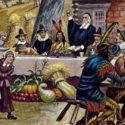Thanksgiving is the one time of year when people in the United States think about their colonial heritage. The first American Thanksgiving probably took place in Texas in the 16th century, but the Thanksgiving story centers on a three-day celebration in 1621. The Plymouth colonists — British colonists — were celebrating their first harvest.
England had 13 colonies in what is now the United States. This is the part of the country now called “New England.”
There were also Spanish colonies in places which are now states, including Florida, Texas, California, New Mexico, and Louisiana which included Louisiana, Arkansas, Oklahoma, Missouri, Kansas, Nebraska, Iowa, Minnesota, North Dakota, South Dakota, Wyoming, Montana, Colorado, and Idaho.
Louisiana was a French colony before and after it was a Spanish colony. Part of Maine was a French colony as well. At various times, the Great Lakes region and part of Florida belonged to the French.
All in all, the French and Spanish had much more land in what is now the United States than England had, but English colonists had the United States. And the Thanksgiving story.
The last Spanish colonies
Cuba and Puerto Rico were the last Spanish colonies in the New World. By the 1820s, all other Spanish colonies had gained their independence. Many of them had been passed over to other governments before they became independent — like Louisiana, which returned to France in 1800 and was then sold to the United States. This is what happened to Cuba and Puerto Rico, too. Spain gave both to the United States after the Spanish-American War.
By then, Puerto Rico had been a Spanish colony for four centuries. The first Spanish Governor of Puerto Rico, Ponce de Leon, had begun building San Juan in 1511. El Morro was begun in 1539. Puerto Rico continued as a source of gold and silver, then as a military outpost for Spain, and finally as a plantation economy supplying sugar, coffee, and tobacco to Spain.
In 1879, after years of effort, Puerto Rico was granted a Charter of Autonomy by Spain. Some think of this as a brief period of independence for Puerto Rico, but that is not the case. These were the provisions of the Charter:
- The governor of Puerto Rico was appointed by the king of Spain.
- The governor was empowered to suspend constitutional guarantees and take whatever measures necessary to maintain law and order.
- The governor could negate any measure approved by Puerto Rico’s Legislature and refer them for revision to the Spanish Parliament, if he thought said measures exceeded the powers granted by the Parliament.
- The governor was empowered to suspend sessions of the Puerto Rican House of Representatives and Senate (known as the Administration Council).
- The members of the cabinet were not under the authority of the governor but under that of the Puerto Rican Legislature.
- Seven of the 15 members of the Senate were appointed by the governor.
- The right to make commercial treaties remained under the Spanish government and not under the Puerto Rican government. The same applied to matters concerning custom duties.
- No mention was made of matters concerning immigration, communications, post offices, etc.
- All matters concerning the administration of justice and the organizations of the judicial power remained under the Spanish Parliament, which was also empowered to determine Puerto Rico’s economic contribution to the Spanish central government.
- The power of the Spanish Parliament to legislate over Puerto Rico remained unaltered.
- The preamble of the Charter clearly indicated that Spain maintained its sovereignty over Puerto Rico.
Just months later, Spain ceded Puerto Rico to the United States, making it clear that Puerto Rico was still a colony of Spain at that time.
The United States government issued a statement on July 21, 1898: “Puerto Rico will be kept, once taken it will never be released. It will pass forever into the hands of the United States.” Cuba was granted independence, but Puerto Rico remained a territory of the United States.
Is Puerto Rico a colony of the United States?
Some say that Puerto Rico is still a colony. Certainly, many of the items in the Charter of Autonomy are more autonomous in the relationship between the United States and Puerto Rico. Puerto Rico votes for her governor and other members of the local government, though Puerto Rico still can’t make commercial treaties. The United States maintains its sovereignty over Puerto Rico, too. “Puerto Rico is the oldest colony in the world” is a common saying.
Others argue against the idea that Puerto Rico is a colony of the United States. The Oregon Territory was never considered a colony and neither was any other territory in the past. All belonged to the United States, all were under plenary power of Congress, and many had a governor (or a series of governors) appointed by the federal government. For these observers, Puerto Rico is simply a territory that hasn’t yet gotten around to being admitted as a state.
When you celebrate Thanksgiving, look forward to next year, when we may well be giving thanks for the passage of a statehood bill for Puerto Rico.








No responses yet